Another review of the private collection of vintage computing
Hello. My name is Prokhor. I am a radio amateur. My callsign is R2DGO. Like all radio amateurs, I am an enthusiastic person, and one of the facets of my technical hobby is collecting rare computer equipment. I read for a long time on Habrahabr all posts related to the subject of old computer hardware and IT history. And finally, I decided to publish my own. In spite of the fact that there are already quite a lot of articles with a similar theme on Habré, I hope, mine will bring something new.
In my first post I decided to post a short description of my collection. On the first slide - Apple II plus - the most ancient and most valuable exhibit, personally purchased and brought from America: the release date is 1979. In addition, he knows how to receive and transmit RTTY and Morse code, I can work on it digital forms of communication with other radio amateurs.
Main technical characteristics:
- MOS Technology 6502 processor running at 1 MHz
- RAM has a volume of 48 kilobytes
- The ROM has a volume of 8 kilobytes and contains the monitor program and the interpreter of the Applesoft Basic language, developed by Microsoft.
')
On the screen - the simplest example of a program in BASIC is “Hello world”:
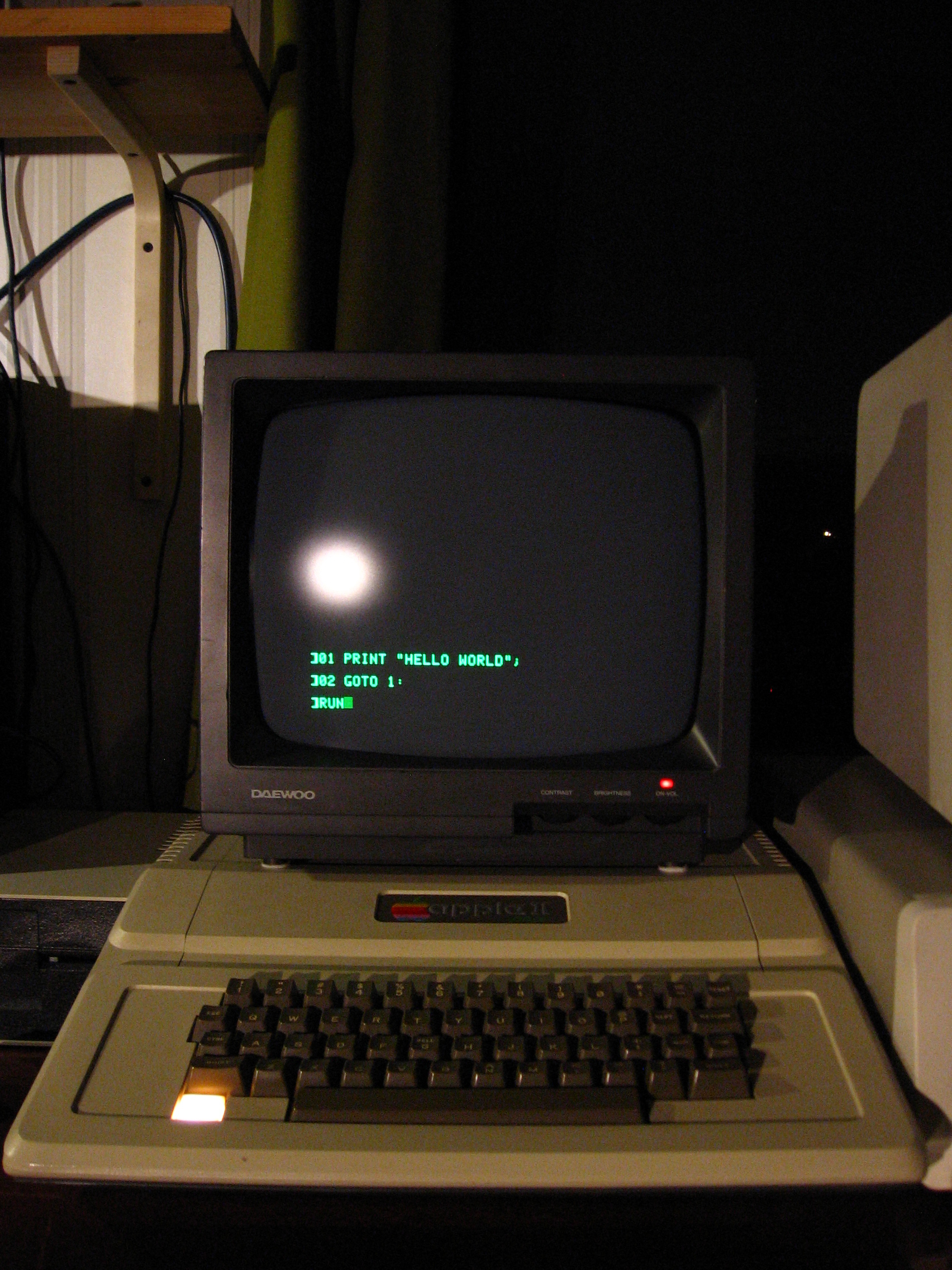
The next exhibit is the IBM PC / XT (aka IBM 5160) from 1983 (judging by the chip marking):

I got it from my work, in one of the Moscow scientific research institutes, where there was a whole “island of dead ships” from decommissioned computers. On the case it is proudly marked: made in UK (this is not some kind of Chinese assembly there).
The monitor did not work at first, but after soldering the dried electrolytic capacitor in the power supply immediately lit up.
I installed DOS and created a small retro collection of toys: the original Soviet Tetris, written by Pajitnov; Ms PACMAN; Prince of Persia; Alley cat; and so on (the collection is gradually growing, because the 20-megabyte hard drive is not yet full.
Main technical characteristics:
- INTEL 8088 processor operating at 4.77 MHz;
- RAM volume of 640 kilobytes;
- ROM contains IBM PC BASIC;
- MFM hard drive with a capacity of 20 megabytes;
- drive for 5-inch floppy disks with a capacity of 360 kilobytes.
Classic Mac:

This is one of the classic "macs" - Macintosh plus 1990 release, this instance is set to the maximum amount of RAM - as much as 4 megabytes! At that time, this thing was the epitome of technology and was admired much more than today's iPhones ... Yes, yes, because long before the appearance of Windows, the Macintosh already had a graphical user interface with windows and a mouse; and in general, like everything apple, the computer was "at the height" not only technically, but also because of its simple and concise, but something special and unique design.
Main technical characteristics:
- Processor: Motorola 68000 at a clock frequency of 8 MHz;
- RAM: 1 Megabyte (possibility of expansion up to 4 Megabyte);
- ROM: contains PO required for booting from floppy disks;
- a drive for 3.5-inch floppy disks (such ones are sold even today), moreover, the floppy disks have their own special format of 800 Kilobytes, the whole “mac” software is adapted to work with such media.
Special attention should be paid to domestic computers (as they were then called personal computers):
This is Agat 9 from my hometown near Moscow; in its time the pioneers mastered the basics of programming and computing:
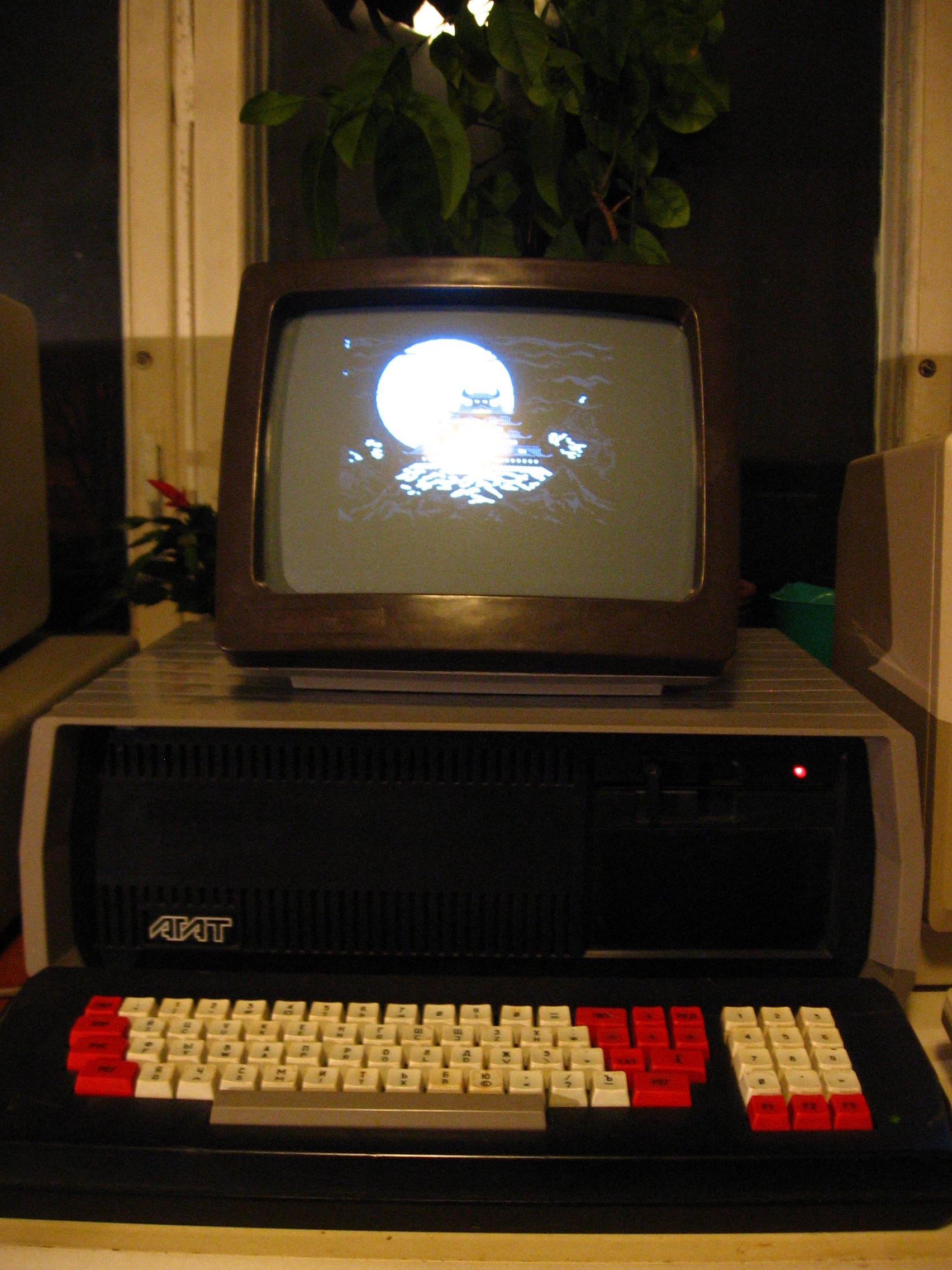
By the way, when I was in school, the 286th cars were already in school (which soon were immediately replaced by Pentium IIIs in my opinion).
Agate is still considered the first Soviet personal computer, it's nice to have such an exhibit. Agates in fact were practically clones of the aforementioned Apple II, although they were not fully compatible, and they imported 6502 Mos Technology into many of the machines, carefully cleaning the chip marking with emery, and signed the “microprocessor chip” on the concept .
Main technical characteristics:
- processor 6502 operating at a clock frequency of 1 MHz;
- RAM of 128 kilobytes;
- ROM with a volume of 2 Kilobytes contains only the system monitor;
- floppy disk drive (drive for 5-inch floppy disk with a volume of 840 kilobytes).
And this is the Search - a domestic IBM-compatible computer, you can even run MS-DOS on it, just get the drive controller ...
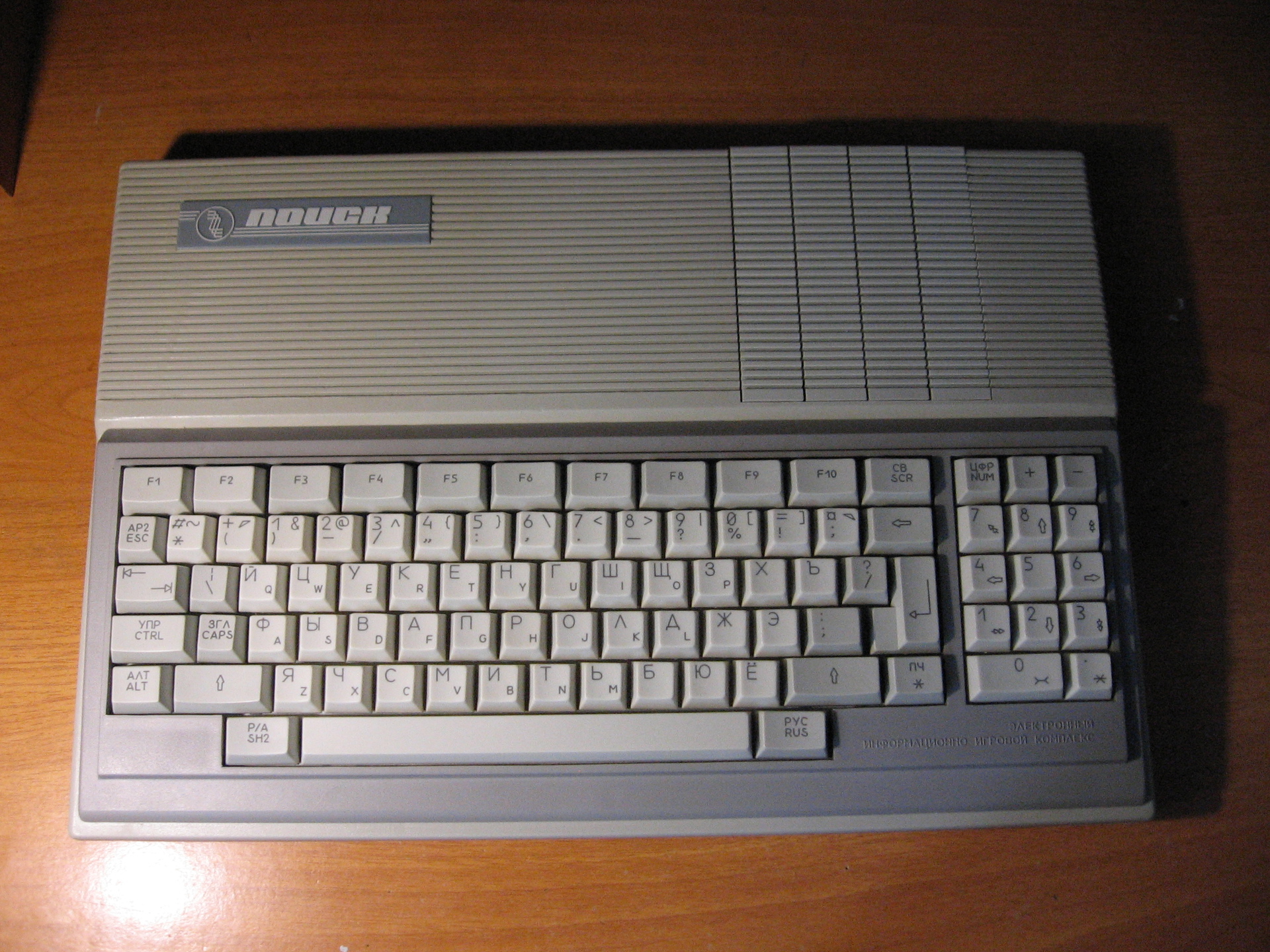
The exhibit went to me as a gift completely new, fully equipped, which pleases.
Main technical characteristics:
- processor: KM1810VM88 (Soviet analogue of INTEL 8088) operates at a frequency of 5 MHz;
- RAM has a volume of 128 kilobytes;
- ROM has a volume of 8 kilobytes and contains the BIOS; when turned on, the bootloader starts up, which displays a menu where you are offered to choose a boot method (from a magnetic tape or from an external ROM). Even BASIC must be downloaded from the cassette.
And another representative of the domestic computer technology - BC 0010:
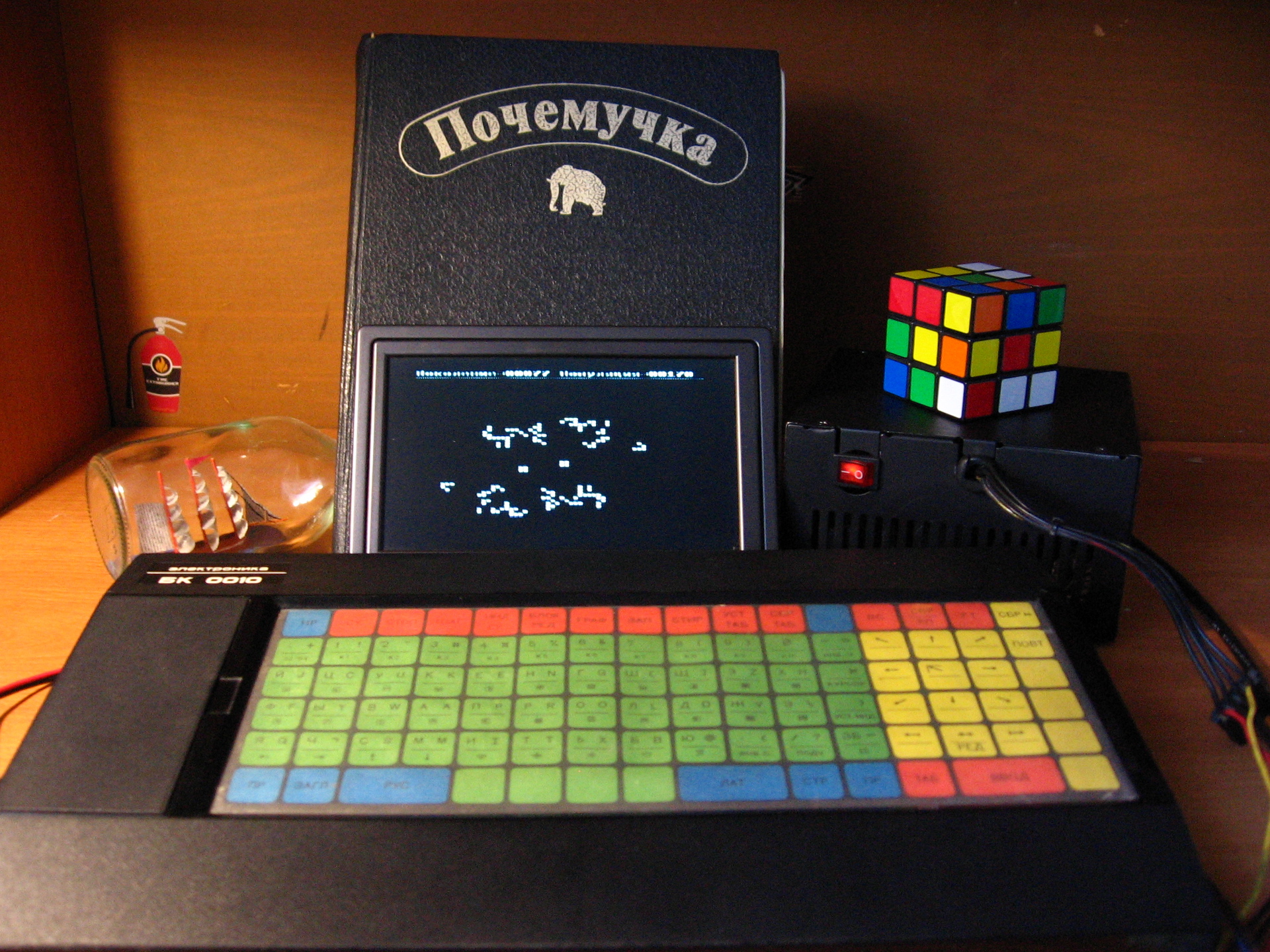
This copy was produced in 1987. Many schools and other educational institutions were also equipped with this computer and its other modifications (even universities - my hobby began with the fact that I saw this computer in the department of General and Inorganic Chemistry of the Biology and Chemistry Faculty of the Moscow State University, where I studied). On a modern LCD screen connected to the video output, a combination of Conway's cellular “Life” machine is being developed, upwards are the counters of generations and the number of cells in a given generation. Despite its discreet name (BK stands for “home computer”), this is a pretty serious machine, compatible with the legendary DEC PDP-11 at the assembler level, and you can run UNIX on it. It was with the use of such computers on February 14, 1987 that the first digital QSO (radio communication) between two radio amateurs, UA3CR and UZ3AXJ, was conducted on the territory of the USSR. Before that, of course, there was a teletype, but this was exactly the first computer radio link that allows you to transfer any files and data.
Main technical characteristics:
- Processor: 1801VM1 operating at a frequency of 3 MHz;
- RAM has a volume of 32 kilobytes;
- ROM - could vary depending on the configuration (on the left behind the sliding curtain there is access to the panels with ROM chips on the board - in my case, in addition to the monitor, the ROM is sewn with Vilnius BASIC).
Homemade clone ZX Spectrum. Such computers were collected by many radio amateurs (due to the sufficient simplicity of the circuit, the minimum number of deficient microcircuits and, consequently, the possibility of repetition), and the same BC or Agat were very expensive; Because of these facts, it is the "specs" that gained enormous popularity among the people.
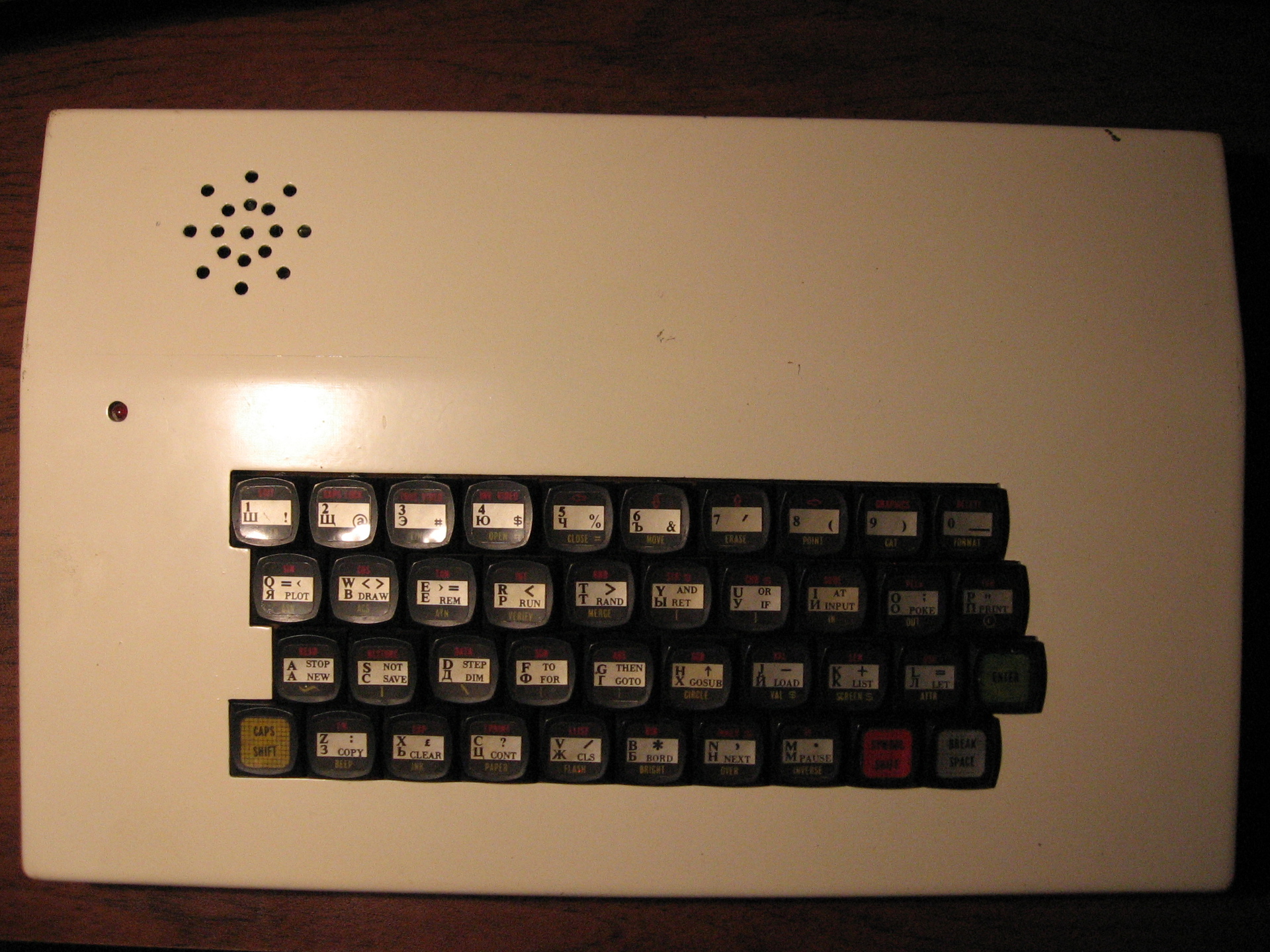
The case is very high quality made of foil-clad fiberglass, all its elements are soldered on the back side with tin (!) - truly amateur radio:
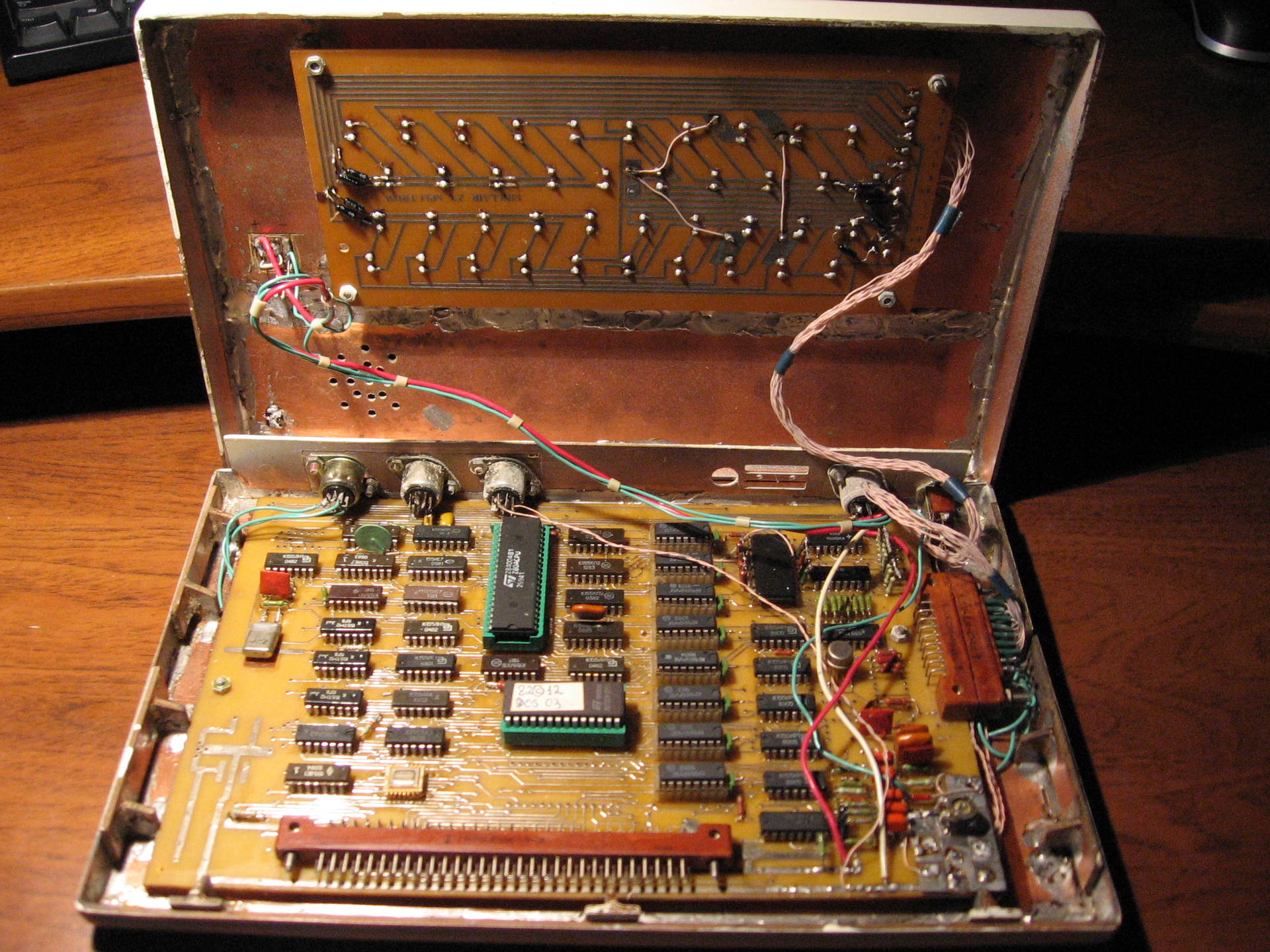
Another clone of the Spectrum, this time the factory:

This is SINTEZ-M, one of the many serially produced clones of the Spectrum in the USSR, it is clear that its developers wanted to achieve not only complete software compatibility with the original, but also to repeat the style and design of the company's Sinclair case.
Main technical characteristics of the computer ZX Spectrum:
- Processor: Z80, clocked at 3.5 MHz;
- RAM has a volume of 48 kilobytes;
- ROM of 16 kilobytes contains Sinclair BASIC;
- for recording and reading programs using a tape of a household cassette recorder.
You are not tired yet? Then a couple of interesting things:
Japanese computer standard MSX:

That's what inspired the creators of the film "The Matrix."
Main technical characteristics:
- Processor: Z80;
- RAM has a volume of 64 kilobytes;
- The ROM contains MSX BASIC and a funny character generator with Japanese hieroglyphs.
The Soviet calculator ISKRA - 111 on low-level integrated circuits with an indicator on gas-discharge lamps (in the English-language literature known as "nixie-tubes"):
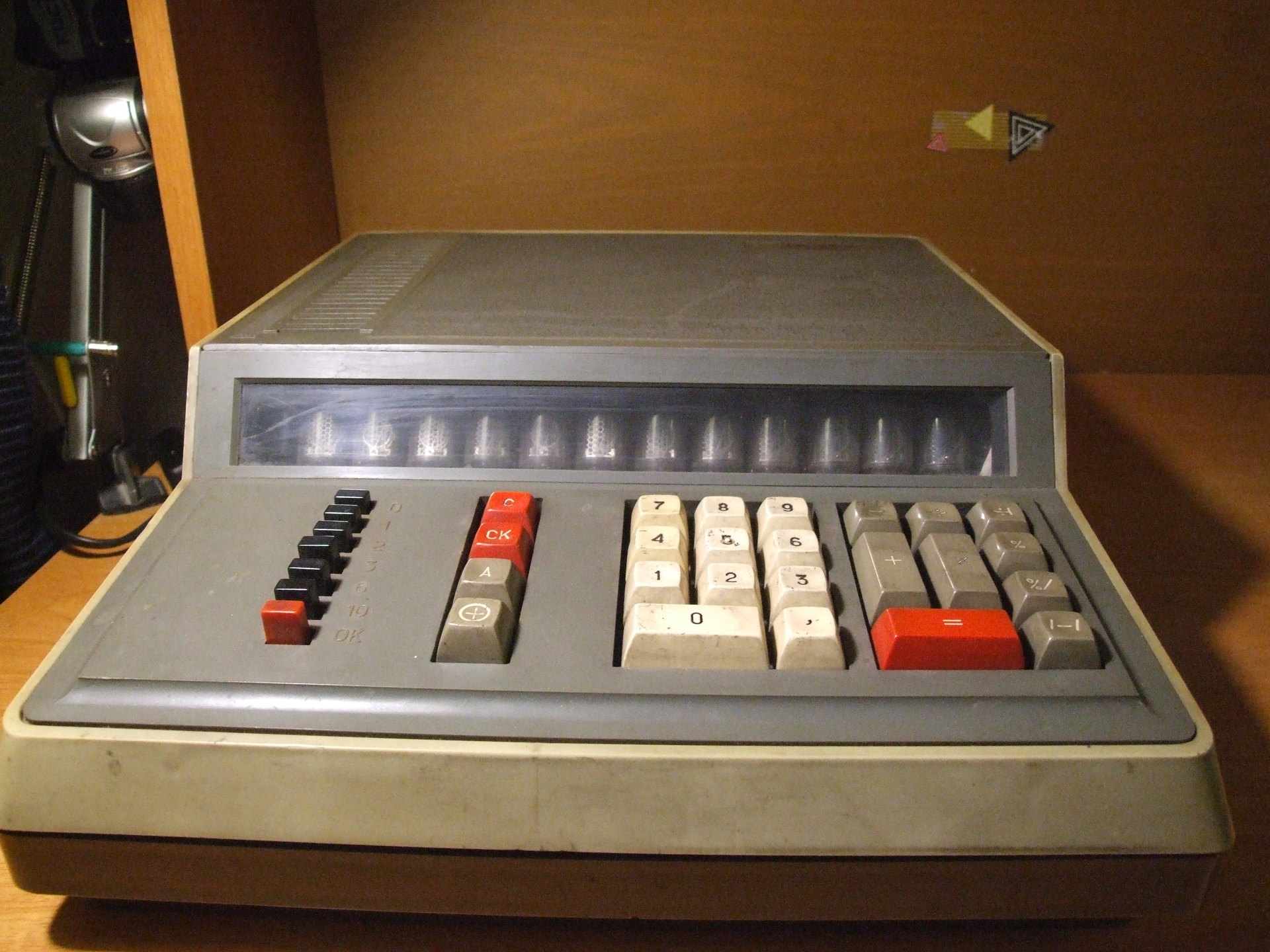
The power supply is corrupted in the calculator - it is being repaired.
Retro modding:

Inside:
- INTEL 80386 @ 33MHz;
- 4 megabytes of RAM;
- MFM-hard drive on 40 megabytes;
- VGA video controller.
General view of the exposure:
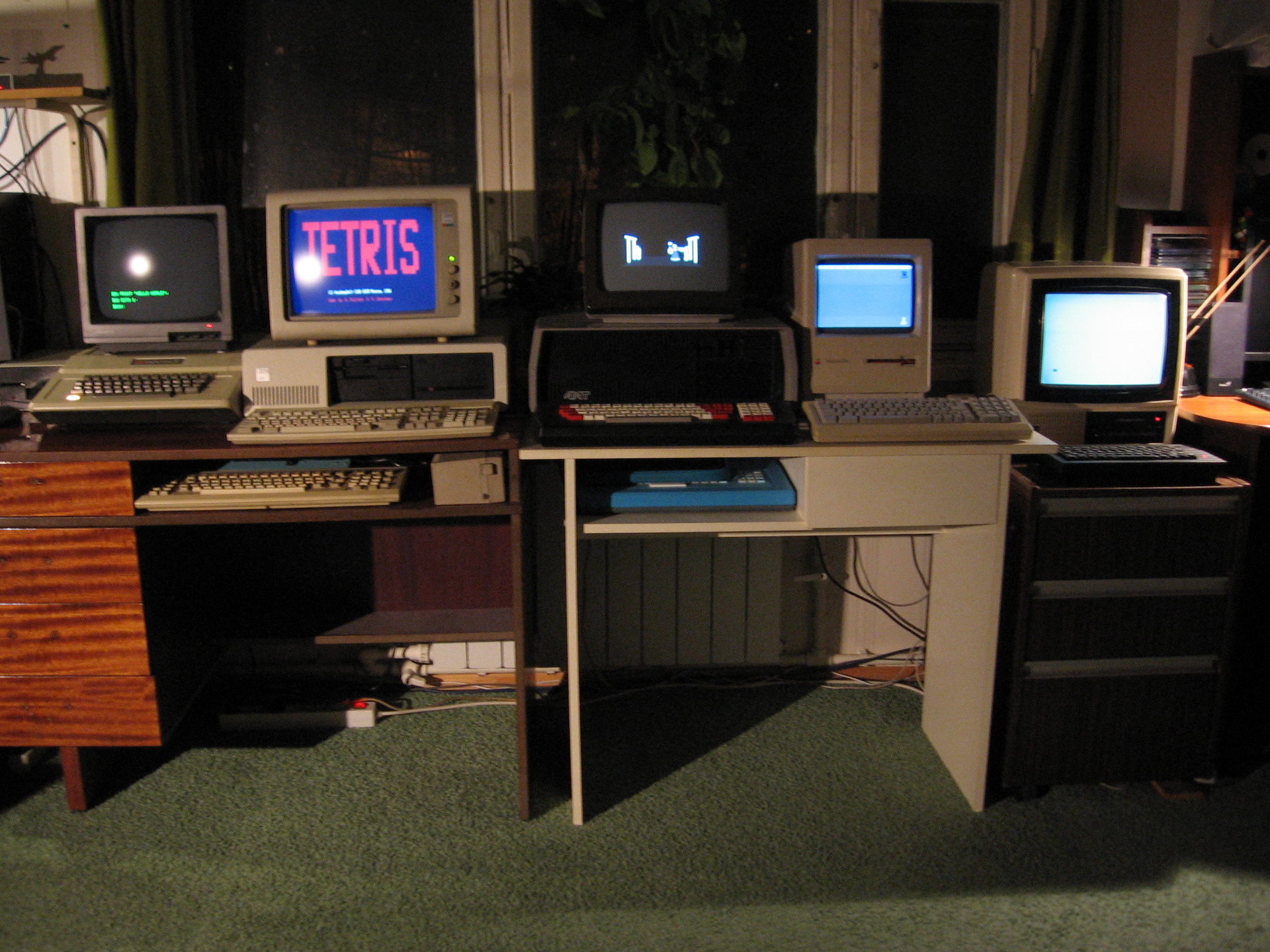
Actually the keeper of the collection:

Thanks for paying attention, I hope it was interesting.
In the future, I plan to write a few more articles in which each exhibit will be considered in more detail, as well as aspects of its real and possible use in amateur radio communications.
In my first post I decided to post a short description of my collection. On the first slide - Apple II plus - the most ancient and most valuable exhibit, personally purchased and brought from America: the release date is 1979. In addition, he knows how to receive and transmit RTTY and Morse code, I can work on it digital forms of communication with other radio amateurs.
Main technical characteristics:
- MOS Technology 6502 processor running at 1 MHz
- RAM has a volume of 48 kilobytes
- The ROM has a volume of 8 kilobytes and contains the monitor program and the interpreter of the Applesoft Basic language, developed by Microsoft.
')
On the screen - the simplest example of a program in BASIC is “Hello world”:
The next exhibit is the IBM PC / XT (aka IBM 5160) from 1983 (judging by the chip marking):
I got it from my work, in one of the Moscow scientific research institutes, where there was a whole “island of dead ships” from decommissioned computers. On the case it is proudly marked: made in UK (this is not some kind of Chinese assembly there).
The monitor did not work at first, but after soldering the dried electrolytic capacitor in the power supply immediately lit up.
I installed DOS and created a small retro collection of toys: the original Soviet Tetris, written by Pajitnov; Ms PACMAN; Prince of Persia; Alley cat; and so on (the collection is gradually growing, because the 20-megabyte hard drive is not yet full.
Main technical characteristics:
- INTEL 8088 processor operating at 4.77 MHz;
- RAM volume of 640 kilobytes;
- ROM contains IBM PC BASIC;
- MFM hard drive with a capacity of 20 megabytes;
- drive for 5-inch floppy disks with a capacity of 360 kilobytes.
Classic Mac:
This is one of the classic "macs" - Macintosh plus 1990 release, this instance is set to the maximum amount of RAM - as much as 4 megabytes! At that time, this thing was the epitome of technology and was admired much more than today's iPhones ... Yes, yes, because long before the appearance of Windows, the Macintosh already had a graphical user interface with windows and a mouse; and in general, like everything apple, the computer was "at the height" not only technically, but also because of its simple and concise, but something special and unique design.
Main technical characteristics:
- Processor: Motorola 68000 at a clock frequency of 8 MHz;
- RAM: 1 Megabyte (possibility of expansion up to 4 Megabyte);
- ROM: contains PO required for booting from floppy disks;
- a drive for 3.5-inch floppy disks (such ones are sold even today), moreover, the floppy disks have their own special format of 800 Kilobytes, the whole “mac” software is adapted to work with such media.
Special attention should be paid to domestic computers (as they were then called personal computers):
This is Agat 9 from my hometown near Moscow; in its time the pioneers mastered the basics of programming and computing:
By the way, when I was in school, the 286th cars were already in school (which soon were immediately replaced by Pentium IIIs in my opinion).
Agate is still considered the first Soviet personal computer, it's nice to have such an exhibit. Agates in fact were practically clones of the aforementioned Apple II, although they were not fully compatible, and they imported 6502 Mos Technology into many of the machines, carefully cleaning the chip marking with emery, and signed the “microprocessor chip” on the concept .
Main technical characteristics:
- processor 6502 operating at a clock frequency of 1 MHz;
- RAM of 128 kilobytes;
- ROM with a volume of 2 Kilobytes contains only the system monitor;
- floppy disk drive (drive for 5-inch floppy disk with a volume of 840 kilobytes).
And this is the Search - a domestic IBM-compatible computer, you can even run MS-DOS on it, just get the drive controller ...
The exhibit went to me as a gift completely new, fully equipped, which pleases.
Main technical characteristics:
- processor: KM1810VM88 (Soviet analogue of INTEL 8088) operates at a frequency of 5 MHz;
- RAM has a volume of 128 kilobytes;
- ROM has a volume of 8 kilobytes and contains the BIOS; when turned on, the bootloader starts up, which displays a menu where you are offered to choose a boot method (from a magnetic tape or from an external ROM). Even BASIC must be downloaded from the cassette.
And another representative of the domestic computer technology - BC 0010:
This copy was produced in 1987. Many schools and other educational institutions were also equipped with this computer and its other modifications (even universities - my hobby began with the fact that I saw this computer in the department of General and Inorganic Chemistry of the Biology and Chemistry Faculty of the Moscow State University, where I studied). On a modern LCD screen connected to the video output, a combination of Conway's cellular “Life” machine is being developed, upwards are the counters of generations and the number of cells in a given generation. Despite its discreet name (BK stands for “home computer”), this is a pretty serious machine, compatible with the legendary DEC PDP-11 at the assembler level, and you can run UNIX on it. It was with the use of such computers on February 14, 1987 that the first digital QSO (radio communication) between two radio amateurs, UA3CR and UZ3AXJ, was conducted on the territory of the USSR. Before that, of course, there was a teletype, but this was exactly the first computer radio link that allows you to transfer any files and data.
Main technical characteristics:
- Processor: 1801VM1 operating at a frequency of 3 MHz;
- RAM has a volume of 32 kilobytes;
- ROM - could vary depending on the configuration (on the left behind the sliding curtain there is access to the panels with ROM chips on the board - in my case, in addition to the monitor, the ROM is sewn with Vilnius BASIC).
Homemade clone ZX Spectrum. Such computers were collected by many radio amateurs (due to the sufficient simplicity of the circuit, the minimum number of deficient microcircuits and, consequently, the possibility of repetition), and the same BC or Agat were very expensive; Because of these facts, it is the "specs" that gained enormous popularity among the people.
The case is very high quality made of foil-clad fiberglass, all its elements are soldered on the back side with tin (!) - truly amateur radio:
Another clone of the Spectrum, this time the factory:

This is SINTEZ-M, one of the many serially produced clones of the Spectrum in the USSR, it is clear that its developers wanted to achieve not only complete software compatibility with the original, but also to repeat the style and design of the company's Sinclair case.
Main technical characteristics of the computer ZX Spectrum:
- Processor: Z80, clocked at 3.5 MHz;
- RAM has a volume of 48 kilobytes;
- ROM of 16 kilobytes contains Sinclair BASIC;
- for recording and reading programs using a tape of a household cassette recorder.
You are not tired yet? Then a couple of interesting things:
Japanese computer standard MSX:

That's what inspired the creators of the film "The Matrix."
Main technical characteristics:
- Processor: Z80;
- RAM has a volume of 64 kilobytes;
- The ROM contains MSX BASIC and a funny character generator with Japanese hieroglyphs.
The Soviet calculator ISKRA - 111 on low-level integrated circuits with an indicator on gas-discharge lamps (in the English-language literature known as "nixie-tubes"):
The power supply is corrupted in the calculator - it is being repaired.
Retro modding:

Inside:
- INTEL 80386 @ 33MHz;
- 4 megabytes of RAM;
- MFM-hard drive on 40 megabytes;
- VGA video controller.
General view of the exposure:
Actually the keeper of the collection:
Thanks for paying attention, I hope it was interesting.
In the future, I plan to write a few more articles in which each exhibit will be considered in more detail, as well as aspects of its real and possible use in amateur radio communications.
Source: https://habr.com/ru/post/239319/
All Articles